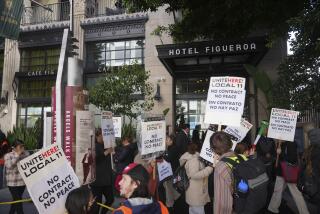Bus Strike Drives Home Points About Economics in the Real World
If you want to see a real-life economic trend at work go to the Greyhound depot in downtown San Diego.
The depot at Broadway and 1st Avenue is under siege by striking members of Amalgamated Transit Union 1222. Eighty-eight of 89 drivers in San Diego are part of a nationwide strike.
The Dallas-based management has hired permanent replacements and put on extra security. Even after the strike is settled, strikers run the risk of finding that their jobs are filled.
Labor analysts say thatâs the modern management way: using permanent replacement workers as a weapon. It began with the 1981 strike of federal air-traffic controllers.
âAs a threat, itâs a big stick,â says Joe Francis, secretary-treasurer of the San Diego-Imperial Counties Labor Council. âIt can be very effective.â
It was the presence of replacement workers holed up in Mission Valley hotels that caused the San Diego Newspaper Guild to blink in the midnight showdown last Dec. 22 with the Union-Tribune Co.
After the strike threat passed, the companyâs interest in reaching a compromise waned considerably.
Neil Bernstein, a professor of labor law at Washington University in St. Louis, faxed a statement to dozens of newspapers recently saying that the historic balance between labor and management is now ominously tilted toward management. He predicts more violence on the picket line.
I talked to the pickets at Broadway and 1st. I found them in amazingly good cheer.
âWeâre in it for the long haul,â said shop steward Chris Shaw. âThe companyâs losing money and weâre getting stronger.â
A Greyhound spokesman said just the opposite: that nearly half of routes nationwide are being driven by replacement drivers or union members who have crossed the picket lines.
Joining the San Diego drivers on the picket line was Caroline Elliott, a San Diego-based flight attendant for Trans World Airlines. Attendants struck for 70 days in 1986 and then returned to work unconditionally in an effort to save their jobs.
Even at that, it was two years before enough replacements had quit so that all of the striking attendants could get their jobs back.
So far, the violence and gunfire seen elsewhere in the Greyhound strike have yet to come to San Diego.
Itâs common to think San Diego is immune to all but the jolliest of national phenomena. But I see no reason that San Diego wonât get its share of labor violence if Prof. Bernstein is correct.
Itâs in the San Diego tradition.
On March 10, 1912, not far from Broadway and 1st, firefighters used high-pressure hoses to disperse an angry mob that had formed outside the jail where organizers from the Industrial Workers of the World were.
Two months later Emma Goldman was run out of town in the middle of the night, and her manager was tarred and feathered near Penasquitos Ranch.
Next time itâll be done with restraining orders and nunchakus.
Haven for Wine Guzzlers
Good news for everyone who likes to guzzle Thunderbird, Night Train, Mad Dog 20-20 and other brands of cheap but strong wine.
Youâve got a friend at San Diego City Hall: Councilman John Hartley.
Hartley on Wednesday convinced his colleagues on a council committee to remove neighborhoods in Hartleyâs district from a proposed ordinance to limit the number of new outlets selling fortified wine.
The ordinance was supposed to cover mid-city neighborhoods eastward from California 163.
City staffers noted that many of the neighborhoods have a crime rate well above the city average, an indicator police use in deciding when to recommend restrictions on the sale of alcohol.
Nonsense, said Hartley. He said he hadnât heard of any problems with fortified wine in his district.
Maybe he should talk with Cleo Malone, executive director of The Palavra Tree, a neighborhood recovery program for alcoholics in San Diego. Malone calls fortified wine âthe cheapest, most powerful drug available.â
âJohn needs to get educated,â Malone said. âI could show him places in his district where people are passed out by noon on a âshortdogâ (half-pint) for 40 cents.
âLives and neighborhoods are being ruined.â
More to Read
Sign up for Essential California
The most important California stories and recommendations in your inbox every morning.
You may occasionally receive promotional content from the Los Angeles Times.










